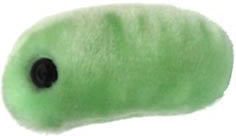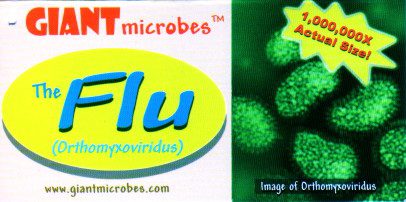

I came across the influenza plush toy in my desk this weekend. The color – green – and the two eyes are gratuitous additions that have nothing to do with reality. Of course, virus particles are too small to have color, but a colorless – or eyeless – toy line would have little appeal to children.
What about that elongated shape? Influenza virions are pleomorphic; they are generally spherical, but filamentous particles are often observed in fresh clinical isolates. So the shape is acceptable. But the soft velvety material bears no resemblance to the surface glycoproteins found of the surface of real influenza virions.


What about the size on that label – ‘1,000,0000x Actual Size!’ – is that correct? A typical influenza virion is 100 nanometers in diameter (1 nanometer is 10-9 meters). By my calculation, 1,000,000 times 100 nanometers is 0.1 meters or 100 millimeters long. It’s in the right range.
Here is the text that is inside that label:
FACTS: The flu, a.k.a. influenza, is a respiratory infection caused by strains of orthomyxoviridae. The word “influenza” comes from the Italian word for influence – back when the stars were thought to influence the start of an epidemic!
Every year 5% – 40% of the population gets the flu. Fortunately, most people recover completely in a couple of weeks. Even more fortunately, since there are only about a dozen different flu viruses, vaccines have been developed that can be up to 90% effective in preventing infection in the first place.
These vaccines, or “flu shots”, are best taken in the fall before the flu season starts, since it can take several weeks for them to become fully effective. (However, since eggs are used to make the vaccines, people who are allergic to eggs should not get the shots.)
In 1918, before there were any vaccines, there was a worldwide pandemic of Spanish flu. Twenty million people were killed. Maybe today we should thank our lucky stars for the vaccines!
That text isn’t bad – but there are a few errors:
- As a virus family name, Orthomyxoviridae should be italicized and capitalized.
- There are certainly much more than ‘a dozen different flu viruses’. Even without considering the animal strains, what about the different strains that arise every year or two that force the production of a new vaccine?
- There are now influenza vaccines that are inhaled (Flumist), as well as versions produced in cell culture.
- In 1918 more than 20 million people were killed by influenza.
Making an influenza toy that isn’t structurally correct can be forgiven, because it might get children interested in viruses. But putting wrong information on the label – the part that parents will read – is unacceptable.
Now a ‘swine flu’ plush toy is available from Giant Microbes – yes, it’s pink, and looks like a pig snout, complete with eyes and nostrils.
If you are writing a book, article, toy label, or anything having to do with viruses, and you are not sure of the science, feel free to contact me for advice. I will check the facts for free, because my goal is for everyone to get the science right.

I once received a “Giant Microbes” EBV toy from a colleague. It is pink and has eyes. The fact card as I remember it seemed on the whole pretty accurate – without mentioning Burkitt's Lymphoma or nasopharyngeal caricnoma, two diseases caused by EBV that the market population for the toy generally doesn't get from EBV. Mono was the focus. I certainly agree with your sentiments though.
Pingback: Tweets that mention Even toy makers should get the science right -- Topsy.com
Excellent blog, I agree that everyone should get viruses right.
Delightful post.
I always got the idea that those toys were for grown-up science geeks (as I am) rather than for actual children 🙂
You might be right about that…many microbiologists I know have them!
But my kids love them too. I just wish I had thought of making them…
Yes, there are many ridiculous 'Giant Microbes'. It is a shame they have the facts off in many of their cards, but as you said the appearance is forgivable. You can't take them too seriously, though. They sell a 'book worm' microbe, as well as 'martian life form' now (some rod-shaped red microbe?).
I've always felt that they did a really good job with the T4 toy. Also, the rhabdovirus has a bit of a bullet shape to it, which I appreciated. Most of the rest are just balls with eyes. My virology professor bought his daughter one, and she insists on calling it a peanut. 🙂
Yep, I've got several giant microbes toys — I like to have one for every species on which I work.
Yep, I've got several giant microbes toys — I like to have one for every species on which I work.
Pingback: Contagion, the movie
Children are natural scientists, always discovering and absorbing new things. Parents can help their children by supplying them with the appropriate science supplies so that they can make a better sense of what they see in the world. Science is trying to explain what you see. Parental involvement in anything; be it sports; school supplies or some hobby is the real key to success for every child. When education supplies are involved a child will set off in new directions with an exceptional level of confidence.
Some kids just don't like to do science fair projects but their school demands that they do. Here are fun ideas and science tips for the reluctant kid as well as the enthusiastic student.
Pingback: GIANTmicrobes at Eye Ball - "Somewhere between edutainment and entercation…"